Spring04:JdbcTemplate及事务控制(AOP、XML、注解)
- Spring中的JdbcTemplate
- 作业:Spring基于AOP的事务控制
- Spring中的事务控制
- 基于XML的
- 基于注解的
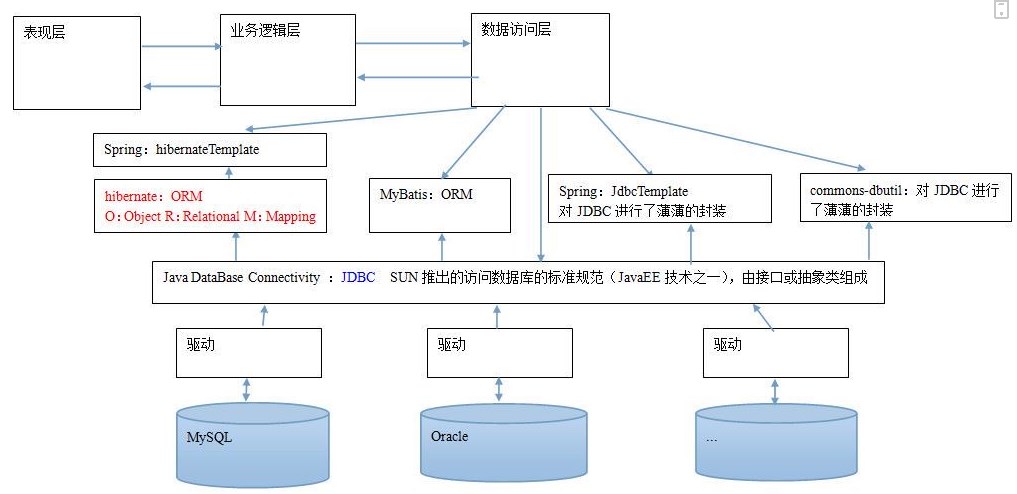
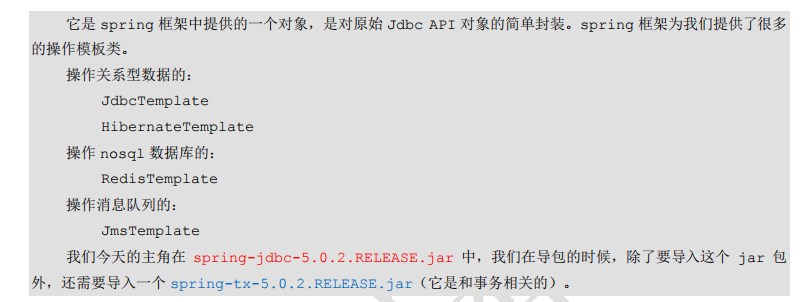
- JdbcTemplate的作用
- 用于和数据库交互,实现对表的CRUD操作
- 如何获取该对象
- 对象中的常用方法
package com.itheima.jdbcTemplate;import org.springframework.jdbc.core.JdbcTemplate;import org.springframework.jdbc.datasource.DriverManagerDataSource;import java.sql.DriverManager;/*** JdbcTemplate的最基本用法*/public class JdbcTemplateDemo1 {public static void main(String[] args) {//准备数据源:c3p0、dbcp都可,今天介绍Spring的内置数据源DriverManagerDataSource ds = new DriverManagerDataSource();ds.setDriverClassName("com.mysql.jdbc.Driver");ds.setUrl("jdbc:mysql://localhost:3306/eesy");ds.setUsername("root");ds.setPassword("root");//1.创建JdbcTemplate对象JdbcTemplate jt = new JdbcTemplate();//可以加带数据源的构造方法//给jt设置数据源jt.setDataSource(ds);//2.执行操作jt.execute("insert into account(name,money) values('ccc',1000)");}}
<?xml version="1.0" encoding="UTF-8"?><beans xmlns="http://www.springframework.org/schema/beans"xmlns:xsi="http://www.w3.org/2001/XMLSchema-instance"xsi:schemaLocation="http://www.springframework.org/schema/beanshttp://www.springframework.org/schema/beans/spring-beans.xsd"><!--配置JdbcTemplate--><bean id="jdbcTemplate" class="org.springframework.jdbc.core.JdbcTemplate"><property name="dataSource" ref="dataSource"></property></bean><bean id="dataSource" class="org.springframework.jdbc.datasource.DriverManagerDataSource"><property name="driverClassName" value="com.mysql.jdbc.Driver"></property><property name="url" value="jdbc:mysql://localhost:3306/eesy"></property><property name="username" value="root"></property><property name="password" value="root"></property></bean></beans>
package com.itheima.jdbcTemplate;import org.springframework.context.ApplicationContext;import org.springframework.context.support.ClassPathXmlApplicationContext;import org.springframework.jdbc.core.JdbcTemplate;import org.springframework.jdbc.datasource.DriverManagerDataSource;import java.sql.DriverManager;/*** JdbcTemplate的最基本用法*/public class JdbcTemplateDemo1 {public static void main(String[] args) {//1.获取容器ApplicationContext ac = new ClassPathXmlApplicationContext("bean.xml");//2.获取对象JdbcTemplate jt = ac.getBean("jdbcTemplate",JdbcTemplate.class);//2.执行操作jt.execute("insert into account(name,money) values('ccc',1000)");}}


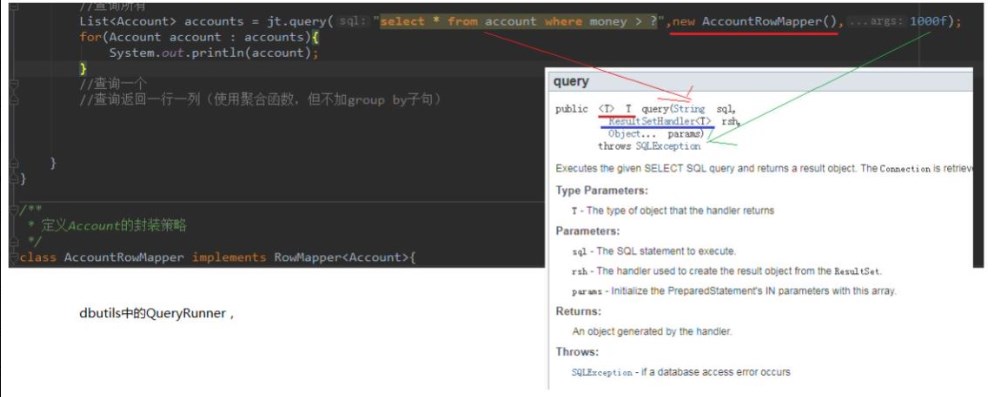
package com.itheima.jdbcTemplate;import com.itheima.domain.Account;import org.springframework.context.ApplicationContext;import org.springframework.context.support.ClassPathXmlApplicationContext;import org.springframework.jdbc.core.BeanPropertyRowMapper;import org.springframework.jdbc.core.JdbcTemplate;import org.springframework.jdbc.core.RowMapper;import java.sql.ResultSet;import java.sql.SQLException;import java.util.List;/*** JdbcTemplate的CRUD操作*/public class JdbcTemplateDemo3 {public static void main(String[] args) {//1.获取容器ApplicationContext ac = new ClassPathXmlApplicationContext("bean.xml");//2.获取对象JdbcTemplate jt = ac.getBean("jdbcTemplate",JdbcTemplate.class);//2.可带参数的执行操作(单表)//保存//jt.update("insert into account(name,money) values (?,?)","ssss",333f);//更新//jt.update("update account set name=?,money=? where id=?","ssss",333f,5);//删除//jt.update("delete from account where id=?",1);//查询所有//queryRunner提供的//List<Account> accounts = jt.query("select * from account where money > ?",new AccountRowMapper(),100f);//Spring提供的/*List<Account> accounts1 = jt.query("select * from account where money > ?",new BeanPropertyRowMapper<Account>(Account.class),100f);for (Account account : accounts1) {System.out.println(account);}*///查询一个/*List<Account> account = jt.query("select * from account where id = ?",new BeanPropertyRowMapper<Account>(Account.class),1);System.out.println(account.isEmpty()?"没有内容":account.get(0));*///使用聚合函数查询,返回一行一列,但不加groupby子句//int count = jt.queryForObject("select count(*) from account where money >= ?",Integer.class,100f);Long count = jt.queryForObject("select count(*) from account where money >= ?",Long.class,100f);//大数据,常用long接收System.out.println(count);}}/*** 定义Account的封装策略*/class AccountRowMapper implements RowMapper<Account> {/*** 把结果集中的数据封装到Account中,然后由Spring把每个Account加入到集合中* @param resultSet* @param i* @return* @throws SQLException*/@Overridepublic Account mapRow(ResultSet resultSet, int i) throws SQLException {Account account = new Account();account.setId(resultSet.getInt("id"));account.setName(resultSet.getString("name"));account.setMoney(resultSet.getFloat("money"));return account;}}
<!--配置账户的持久层--><bean id="accountDao" class="com.itheima.dao.impl.AccountDaoImpl"><property name="jdbcTemplate" ref="jdbcTemplate"></property></bean><!--配置JdbcTemplate--><bean id="jdbcTemplate" class="org.springframework.jdbc.core.JdbcTemplate"><property name="dataSource" ref="dataSource"></property></bean>
package com.itheima.dao.impl;import com.itheima.dao.IAccountDao;import com.itheima.domain.Account;import org.springframework.jdbc.core.BeanPropertyRowMapper;import org.springframework.jdbc.core.JdbcTemplate;import java.util.List;/*** 账户的持久层实现类*/public class AccountDaoImpl implements IAccountDao {private JdbcTemplate jdbcTemplate;public void setJdbcTemplate(JdbcTemplate jdbcTemplate) {this.jdbcTemplate = jdbcTemplate;}@Overridepublic Account findAccounById(Integer accountId) {List<Account> accounts = jdbcTemplate.query("select * from account where id = ?",new BeanPropertyRowMapper<Account>(Account.class),accountId);return accounts.isEmpty()?null:accounts.get(0);}@Overridepublic Account findAccountByName(String accounName) {List<Account> accounts = jdbcTemplate.query("select * from account where name = ?",new BeanPropertyRowMapper<Account>(Account.class),accounName);if (accounts.isEmpty()){return null;}if (accounts.size()>1){throw new RuntimeException("结果集不一致");}return accounts.get(0);}@Overridepublic void updateAccount(Account account) {jdbcTemplate.update("update account set name=?,money=? where id=?",account.getName(),account.getMoney(),account.getId());}}
package com.itheima.jdbcTemplate;import com.itheima.dao.IAccountDao;import com.itheima.domain.Account;import org.springframework.context.ApplicationContext;import org.springframework.context.support.ClassPathXmlApplicationContext;import org.springframework.jdbc.core.JdbcTemplate;/*** JdbcTemplate的最基本用法*/public class JdbcTemplateDemo4 {public static void main(String[] args) {//1.获取容器ApplicationContext ac = new ClassPathXmlApplicationContext("bean.xml");//2.获取对象IAccountDao accountDao =ac.getBean("accountDao",IAccountDao.class);Account account = accountDao.findAccounById(5);System.out.println(account);account.setMoney(10000f);accountDao.updateAccount(account);}}

/*** 账户的持久层实现类*/@Repositorypublic class AccountDaoImpl2 implements IAccountDao {@Autowiredprivate JdbcTemplate jdbcTemplate;/*public void setJdbcTemplate(JdbcTemplate jdbcTemplate) {this.jdbcTemplate = jdbcTemplate;}*/@Overridepublic Account findAccounById(Integer accountId) {List<Account> accounts = jdbcTemplate.query("select * from account where id = ?",new BeanPropertyRowMapper<Account>(Account.class),accountId);return accounts.isEmpty()?null:accounts.get(0);}
package com.itheima.dao.impl;import org.springframework.jdbc.core.JdbcTemplate;import javax.sql.DataSource;/*** 此类用于抽取dao中的重复代码*/public class JdbcDaoSupport {private JdbcTemplate jdbcTemplate;public JdbcTemplate getJdbcTemplate() {return jdbcTemplate;}public void setJdbcTemplate(JdbcTemplate jdbcTemplate) {this.jdbcTemplate = jdbcTemplate;}public DataSource getDateSource() {return dateSource;}public void setDateSource(DataSource dateSource) {//this.dateSource = dateSource;if(jdbcTemplate == null){jdbcTemplate = createJdbcTemplate(dateSource);}}private JdbcTemplate createJdbcTemplate(DataSource dateSource) {return new JdbcTemplate(dateSource);//支持构造函数和set方法}private DataSource dateSource;}
/*** 账户的持久层实现类*/public class AccountDaoImpl extends JdbcDaoSupport implements IAccountDao {/*private JdbcTemplate jdbcTemplate;public void setJdbcTemplate(JdbcTemplate jdbcTemplate) {this.jdbcTemplate = jdbcTemplate;}*/@Overridepublic Account findAccounById(Integer accountId) {List<Account> accounts = getJdbcTemplate() .query("select * from account where id = ?",new BeanPropertyRowMapper<Account>(Account.class),accountId);return accounts.isEmpty()?null:accounts.get(0);}
<?xml version="1.0" encoding="UTF-8"?><beans xmlns="http://www.springframework.org/schema/beans"xmlns:xsi="http://www.w3.org/2001/XMLSchema-instance"xsi:schemaLocation="http://www.springframework.org/schema/beanshttp://www.springframework.org/schema/beans/spring-beans.xsd"><!--配置账户的持久层--><bean id="accountDao" class="com.itheima.dao.impl.AccountDaoImpl"><property name="dateSource" ref="dataSource"></property></bean><bean id="dataSource" class="org.springframework.jdbc.datasource.DriverManagerDataSource"><property name="driverClassName" value="com.mysql.jdbc.Driver"></property><property name="url" value="jdbc:mysql://localhost:3306/eesy"></property><property name="username" value="root"></property><property name="password" value="root"></property></bean></beans>
<?xml version="1.0" encoding="UTF-8"?><beans xmlns="http://www.springframework.org/schema/beans"xmlns:xsi="http://www.w3.org/2001/XMLSchema-instance"xmlns:aop="http://www.springframework.org/schema/aop"xsi:schemaLocation="http://www.springframework.org/schema/beanshttp://www.springframework.org/schema/beans/spring-beans.xsdhttp://www.springframework.org/schema/aophttp://www.springframework.org/schema/aop/spring-aop.xsd"><!-- 配置Service --><bean id="accountService" class="com.itheima.service.impl.AccountServiceImpl"><!-- 注入dao对象 --><property name="accountDao" ref="accountDao"></property></bean><!--配置dao对象--><bean id="accountDao" class="com.itheima.dao.impl.AccountDaoImpl"><!--注入QueryRunner--><property name="runner" ref="runner"></property><!--注入ConnectionUtils--><property name="connectionUtils" ref="connectionUtils"></property></bean><!--配置QueryRunner对象--><!--不再提供Connection对象,没有数据源,不会从数据源中获取连接--><bean id="runner" class="org.apache.commons.dbutils.QueryRunner" scope="prototype"></bean><!--配置数据源--><bean id="dataSource" class="com.mchange.v2.c3p0.ComboPooledDataSource"><!--连接数据库的必备信息--><property name="driverClass" value="com.mysql.jdbc.Driver"></property><property name="jdbcUrl" value="jdbc:mysql://localhost:3306/eesy02"></property><property name="user" value="root"></property><property name="password" value="root"></property></bean><!--配置Connection的工具类-ConnectionUtils--><bean id="connectionUtils" class="com.itheima.utils.ConnectionUtils"><!--注入数据源的配置--><property name="dataSource" ref="dataSource"></property></bean><!--配置事务管理器--><bean id="txManager" class="com.itheima.utils.TransactionManager"><!--注入ConnectionUtils--><property name="connectionUtils" ref="connectionUtils"></property></bean><!--配置AOP--><aop:config><aop:aspect id="txAdvice" ref="txManager"><!--配置通用的切入点表达式--><aop:pointcut id="pt1" expression="execution(* com.itheima.service.impl.*.*(..))"/><!--配置前置通知:开启事务--><aop:before method="beginTransaction" pointcut-ref="pt1"></aop:before><!--配置后置通知:提交事务--><aop:after-returning method="commit" pointcut-ref="pt1"></aop:after-returning><!--配置异常通知:回滚事务--><aop:after-throwing method="rollback" pointcut-ref="pt1"></aop:after-throwing><!--配置最终通知:释放连接--><aop:after method="release" pointcut-ref="pt1"></aop:after></aop:aspect></aop:config></beans>
<?xml version="1.0" encoding="UTF-8"?><beans xmlns="http://www.springframework.org/schema/beans"xmlns:xsi="http://www.w3.org/2001/XMLSchema-instance"xmlns:aop="http://www.springframework.org/schema/aop"xmlns:context="http://www.springframework.org/schema/context"xsi:schemaLocation="http://www.springframework.org/schema/beanshttp://www.springframework.org/schema/beans/spring-beans.xsdhttp://www.springframework.org/schema/aophttp://www.springframework.org/schema/aop/spring-aop.xsdhttp://www.springframework.org/schema/contexthttp://www.springframework.org/schema/context/spring-context.xsd"><!--配置Spring创建容器时要扫描的包--><context:component-scan base-package="com.itheima"></context:component-scan><!-- 配置Service --><!--配置QueryRunner对象--><!--不再提供Connection对象,没有数据源,不会从数据源中获取连接--><bean id="runner" class="org.apache.commons.dbutils.QueryRunner" scope="prototype"></bean><!--配置数据源--><bean id="dataSource" class="com.mchange.v2.c3p0.ComboPooledDataSource"><!--连接数据库的必备信息--><property name="driverClass" value="com.mysql.jdbc.Driver"></property><property name="jdbcUrl" value="jdbc:mysql://localhost:3306/eesy02"></property><property name="user" value="root"></property><property name="password" value="root"></property></bean><!--开启Spring对注解aop的支持--><aop:aspectj-autoproxy></aop:aspectj-autoproxy></beans>
package com.itheima.utils;import org.aspectj.lang.annotation.*;import org.springframework.beans.factory.annotation.Autowired;import org.springframework.stereotype.Component;import java.sql.SQLException;/*** 和事务管理相关的工具类,包含开启事务、提交事务、回滚事务和释放连接*/@Component("txManager")public class TransactionManager {//获取当前线程上的Connection@Autowiredprivate ConnectionUtils connectionUtils;@Pointcut("execution(* com.itheima.*.*(..))")private void pt1(){}/*** 开启事务*/@Before("pt1")public void beginTransaction(){try {connectionUtils.getThreadConnection().setAutoCommit(true);} catch (Exception e) {e.printStackTrace();}}/*** 提交事务*/@AfterReturning("pt1")public void commit(){try {connectionUtils.getThreadConnection().commit();} catch (Exception e) {e.printStackTrace();}}/*** 回滚事务*/@AfterThrowing("pt1")public void rollback(){try {connectionUtils.getThreadConnection().rollback();} catch (Exception e) {e.printStackTrace();}}/*** 释放连接*/@After("pt1")public void release(){try {connectionUtils.getThreadConnection().close();//并不是真正关闭连接,而是还回连接池中connectionUtils.removeConnection();//进行线程的解绑} catch (Exception e) {e.printStackTrace();}}}
package com.itheima.utils;import org.springframework.beans.factory.annotation.Autowired;import org.springframework.stereotype.Component;import javax.sql.DataSource;import java.sql.Connection;import java.sql.SQLException;/*** 连接的工具类,用于从数据源中获取一个连接,并且实现和线程的绑定*/@Component("connectionUtils")public class ConnectionUtils {private ThreadLocal<Connection> tl = new ThreadLocal<Connection>();@Autowiredprivate DataSource dataSource;/*** 获取当前线程上的连接*/public Connection getThreadConnection(){try {//1.先从ThreadLocal上获取Connection conn = tl.get();//2.判断当前线程上是否有连接if (conn == null){//3.从数据源中获取一个连接,并且和线程绑定,存入ThreadLocal中conn = dataSource.getConnection();tl.set(conn);}//4.返回当前线程上的连接return conn;} catch (Exception e) {throw new RuntimeException(e);}}/*** 把连接和线程解绑*/public void removeConnection(){tl.remove();}}
package com.itheima.service.impl;import com.itheima.dao.IAccountDao;import com.itheima.domain.Account;import com.itheima.service.IAccountService;import com.itheima.utils.TransactionManager;import org.springframework.beans.factory.annotation.Autowired;import org.springframework.stereotype.Service;import java.util.List;/*** 账户的业务层实现类* 事务控制应当在业务层*/@Service("accountService")public class AccountServiceImpl implements IAccountService {/*** 每次获取连接,无法实现事务控制*/@Autowiredprivate IAccountDao accountDao;@Overridepublic List<Account> findAllAccount() {return accountDao.findAllAccount();}@Overridepublic Account findAccountById(Integer accountId) {//2.执行操作return accountDao.findAccountById(accountId);}@Overridepublic void saveAccount(Account account) {accountDao.saveAccount(account);}@Overridepublic void updateAccount(Account account) {accountDao.updateAccount(account);}@Overridepublic void deleteAccount(Integer accountId) {accountDao.deleteAccount(accountId);}@Overridepublic void transfer(String sourceName, String targetName, Float money) {System.out.println("transfer开始执行");//2.1根据名称查询转出账户Account source = accountDao.findAccountByName(sourceName);//2.2根据名称查询转入账户Account target = accountDao.findAccountByName(targetName);//2.3转出账户金额减少source.setMoney(source.getMoney() - money);//2.4.转入账户金额增加target.setMoney(target.getMoney() + money);//int i = 1 / 0;//2.5.更新转出账户accountDao.updateAccount(source);//2.6.更新转入账户accountDao.updateAccount(target);//3.提交事务//txManager.commit();}}
package com.itheima.utils;import org.aspectj.lang.ProceedingJoinPoint;import org.aspectj.lang.annotation.*;import org.springframework.beans.factory.annotation.Autowired;import org.springframework.stereotype.Component;import java.sql.SQLException;/*** 和事务管理相关的工具类,包含开启事务、提交事务、回滚事务和释放连接*/@Component("txManager")public class TransactionManager {//获取当前线程上的Connection@Autowiredprivate ConnectionUtils connectionUtils;@Pointcut("execution(* com.itheima.*.*(..))")private void pt1(){}/*** 开启事务*/public void beginTransaction(){try {connectionUtils.getThreadConnection().setAutoCommit(true);} catch (Exception e) {e.printStackTrace();}}/*** 提交事务*/@AfterReturning("pt1")public void commit(){try {connectionUtils.getThreadConnection().commit();} catch (Exception e) {e.printStackTrace();}}/*** 回滚事务*/public void rollback(){try {connectionUtils.getThreadConnection().rollback();} catch (Exception e) {e.printStackTrace();}}/*** 释放连接*/public void release(){try {connectionUtils.getThreadConnection().close();//并不是真正关闭连接,而是还回连接池中connectionUtils.removeConnection();//进行线程的解绑} catch (Exception e) {e.printStackTrace();}}@Around("pt1")public Object aroundAdvice(ProceedingJoinPoint pjp){Object rtValue = null;try {//1.获取参数Object[] args = pjp.getArgs();//2.开启事务this.beginTransaction();//3.执行方法rtValue = pjp.proceed(args);//4.提交事务this.commit();//返回结果return rtValue;} catch (Throwable e) {//5.回滚事务this.rollback();throw new RuntimeException(e);} finally {//6.释放资源this.release();}}}
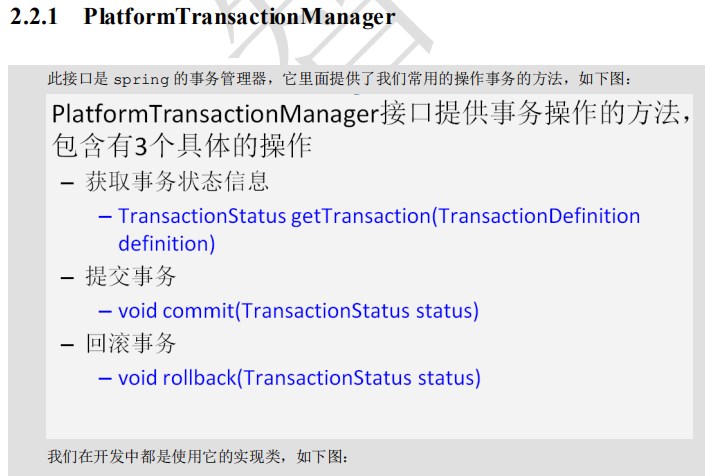

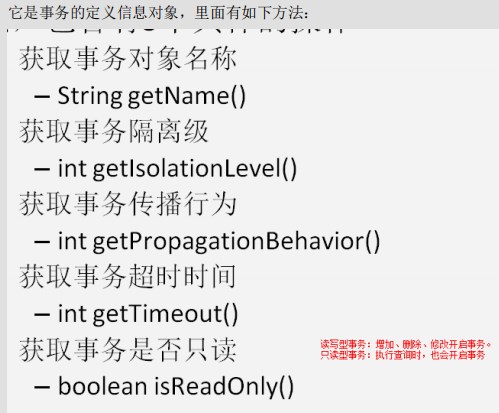
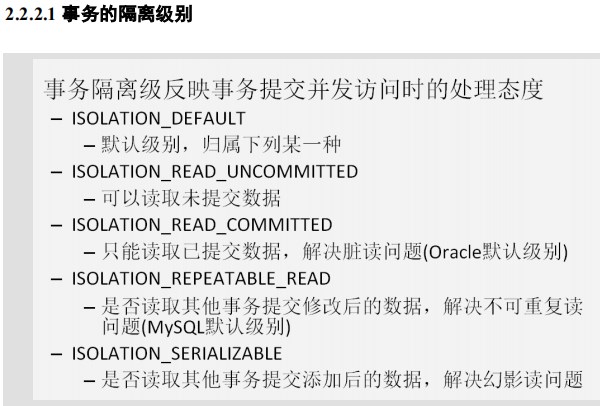

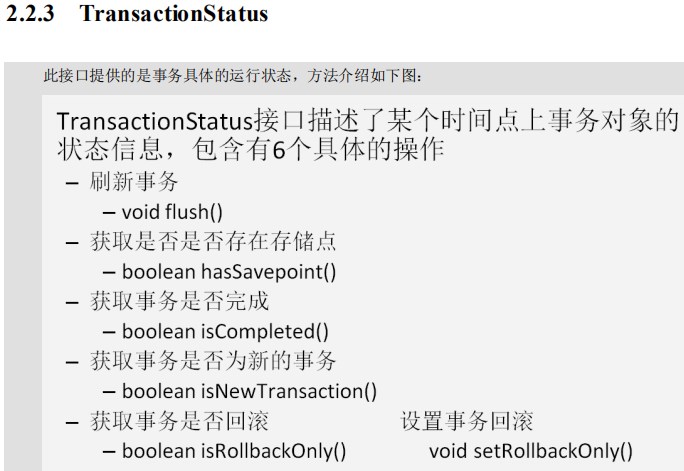
<?xml version="1.0" encoding="UTF-8"?><beans xmlns="http://www.springframework.org/schema/beans"xmlns:xsi="http://www.w3.org/2001/XMLSchema-instance"xsi:schemaLocation="http://www.springframework.org/schema/beanshttp://www.springframework.org/schema/beans/spring-beans.xsd"><!--配置业务层--><bean id="accountService" class="com.itheima.service.impl.AccountServiceImpl"><property name="accountDao" ref="accountDao"></property></bean><!--配置账户的持久层--><bean id="accountDao" class="com.itheima.dao.impl.AccountDaoImpl"><!-- <property name="jdbcTemplate" ref="jdbcTemplate"></property>--><property name="dataSource" ref="dataSource"></property></bean><bean id="dataSource" class="org.springframework.jdbc.datasource.DriverManagerDataSource"><property name="driverClassName" value="com.mysql.jdbc.Driver"></property><property name="url" value="jdbc:mysql://localhost:3306/eesy"></property><property name="username" value="root"></property><property name="password" value="root"></property></bean></beans>
import java.util.List;/*** 使用Junit单元测试:测试我们的配置*/@RunWith(SpringJUnit4ClassRunner.class)@ContextConfiguration(locations = {"classpath:bean.xml"})public class AccountServiceTest {@Autowiredprivate IAccountService as;@Testpublic void testTransfer(){as.transfer("aaa","bbb",100f);}}
<?xml version="1.0" encoding="UTF-8"?><beans xmlns="http://www.springframework.org/schema/beans"xmlns:xsi="http://www.w3.org/2001/XMLSchema-instance"xmlns:aop="http://www.springframework.org/schema/aop"xmlns:tx="http://www.springframework.org/schema/tx"xsi:schemaLocation="http://www.springframework.org/schema/beanshttp://www.springframework.org/schema/beans/spring-beans.xsdhttp://www.springframework.org/schema/txhttp://www.springframework.org/schema/tx/spring-tx.xsdhttp://www.springframework.org/schema/aophttp://www.springframework.org/schema/aop/spring-aop.xsd"><!--配置业务层--><bean id="accountService" class="com.itheima.service.impl.AccountServiceImpl"><property name="accountDao" ref="accountDao"></property></bean><!--配置账户的持久层--><bean id="accountDao" class="com.itheima.dao.impl.AccountDaoImpl"><!-- <property name="jdbcTemplate" ref="jdbcTemplate"></property>--><property name="dataSource" ref="dataSource"></property></bean><bean id="dataSource" class="org.springframework.jdbc.datasource.DriverManagerDataSource"><property name="driverClassName" value="com.mysql.jdbc.Driver"></property><property name="url" value="jdbc:mysql://localhost:3306/eesy"></property><property name="username" value="root"></property><property name="password" value="root"></property></bean><!--Spring中基于XML的声明式事务配置步骤1、配置事务管理器2、配置事务的通知此时需要导入事务的约束:tx名称空间和约束,同时也需要aop的使用tx:advice标签配置事务通知属性:id:给事务通知起一个唯一标识transaction-manager:给事务通知提供一个事务管理器引用3、配置AOP中的通用切入点表达式4、建立事务通知和切入点表达式的对应关系5、配置事务的属性在事务的通知tx:advice标签的内部配置--><!--配置事务管理器--><bean id="transactionManager" class="org.springframework.jdbc.datasource.DataSourceTransactionManager"><property name="dataSource" ref="dataSource"></property></bean><!--配置事务通知的标签--><tx:advice id="txAdvice" transaction-manager="transactionManager"><!--配置事务的属性--><tx:attributes><!--标识transfer是业务层接口的方法,其需要一些属性isolation="" 指定事务的隔离级别,默认是default,表示是数据库的默认隔离级别no-rollback-for="" 用于指定一个异常,当产生该异常时,事务不会滚 ,产生其他异常时,事务回滚。没有默认值,表示任何异常都回滚propagation="" 用于指定事务的传播行为,默认是REQUIRED,表示一定会有事务,增删改的选择,查询方法可以选择SUPPORTread-only="" 指定事务是否只读,只有查询才能设置为true,默认为false表示读写rollback-for="" 用于指定一个异常,当产生异常时,事务回滚。产生其他异常时,事务不回滚,没有默认值,表示任何异常都会滚timeout="" 指定事务的超时时间,默认值是-1,表示永不超时,如果指定了数值,以秒为单位--><tx:method name="*" read-only="false" propagation="REQUIRED"/><!--指定查询方法--><tx:method name="find*" propagation="SUPPORTS" read-only="true"></tx:method></tx:attributes></tx:advice><!--配置AOP--><aop:config><!--配置切入点表达式--><aop:pointcut id="pt1" expression="execution(* com.itheima.*.*(..))"/><!--建立切入点表达式和事务通知的对应关系--><aop:advisor advice-ref="txAdvice" pointcut-ref="pt1"></aop:advisor></aop:config></beans>
<?xml version="1.0" encoding="UTF-8"?><beans xmlns="http://www.springframework.org/schema/beans"xmlns:xsi="http://www.w3.org/2001/XMLSchema-instance"xmlns:aop="http://www.springframework.org/schema/aop"xmlns:tx="http://www.springframework.org/schema/tx"xmlns:context="http://www.springframework.org/schema/context"xsi:schemaLocation="http://www.springframework.org/schema/beanshttp://www.springframework.org/schema/beans/spring-beans.xsdhttp://www.springframework.org/schema/txhttp://www.springframework.org/schema/tx/spring-tx.xsdhttp://www.springframework.org/schema/aophttp://www.springframework.org/schema/aop/spring-aop.xsdhttp://www.springframework.org/schema/contexthttp://www.springframework.org/schema/context/spring-context.xsd"><!--配置业务层--><!--配置spring创建容器时要扫描的包--><context:component-scan base-package="com.itheima"></context:component-scan><!--配置JdbcTemplate--><bean id="jdbcTemplate" class="org.springframework.jdbc.core.JdbcTemplate"><property name="dataSource" ref="dataSource"></property></bean><bean id="dataSource" class="org.springframework.jdbc.datasource.DriverManagerDataSource"><property name="driverClassName" value="com.mysql.jdbc.Driver"></property><property name="url" value="jdbc:mysql://localhost:3306/eesy02"></property><property name="username" value="root"></property><property name="password" value="root"></property></bean><!--Spring中基于注解的声明式事务配置步骤1、配置事务管理器2、开启Spring对注解事务的支持3、在需要事务支持的地方使用@Transactional注解4、建立事务通知和切入点表达式的对应关系5、配置事务的属性在事务的通知tx:advice标签的内部配置--><!--配置事务管理器--><bean id="transactionManager" class="org.springframework.jdbc.datasource.DataSourceTransactionManager"><property name="dataSource" ref="dataSource"></property></bean><!--开启Spring对注解事务的支持--><tx:annotation-driven transaction-manager="transactionManager"></tx:annotation-driven></beans>
package com.itheima.service.impl;import com.itheima.dao.IAccountDao;import com.itheima.domain.Account;import com.itheima.service.IAccountService;import org.springframework.beans.factory.annotation.Autowired;import org.springframework.stereotype.Service;import org.springframework.transaction.annotation.Propagation;import org.springframework.transaction.annotation.Transactional;@Service("accountService")@Transactional(propagation = Propagation.SUPPORTS,readOnly = true)//只读型事务控制public class AccountServiceImpl implements IAccountService {@Autowiredprivate IAccountDao accountDao;@Overridepublic Account findAccountById(Integer accountId) {return accountDao.findAccountById(accountId);}//需要的是读写型事务控制@Transactional(propagation = Propagation.REQUIRED,readOnly = false)//读写型//xml一劳永逸@Overridepublic void transfer(String sourceName, String targetName, Float money) {System.out.println("transfer开始执行");//2.1根据名称查询转出账户Account source = accountDao.findAccountByName(sourceName);//2.2根据名称查询转入账户Account target = accountDao.findAccountByName(targetName);//2.3转出账户金额减少source.setMoney(source.getMoney() - money);//2.4.转入账户金额增加target.setMoney(target.getMoney() + money);//2.5.更新转出账户accountDao.updateAccount(source);//2.6.更新转入账户accountDao.updateAccount(target);//int i = 1 / 0;//3.提交事务//txManager.commit();}}
/*** 账户的持久层实现类*/@Repository("accountDao")public class AccountDaoImpl implements IAccountDao {@Autowiredprivate JdbcTemplate jdbcTemplate;public void setJdbcTemplate(JdbcTemplate jdbcTemplate) {this.jdbcTemplate = jdbcTemplate;}
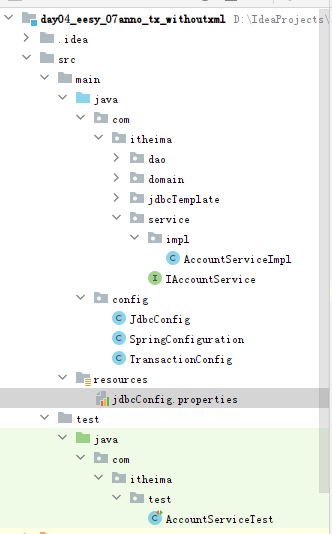
jdbc.driver=com.mysql.jdbc.Driverjdbc.url=jdbc:mysql://localhost:3306/eesy02jdbc.username=rootjdbc.password=rootpackage config;import org.springframework.beans.factory.annotation.Value;import org.springframework.context.annotation.Bean;import org.springframework.jdbc.core.JdbcTemplate;import org.springframework.jdbc.datasource.DriverManagerDataSource;import javax.sql.DataSource;/*** 和连接数据库相关的配置类*/public class JdbcConfig {@Value("${jdbc.driver}")private String driver;@Value("${jdbc.url}")private String url;@Value("${jdbc.username}")private String username;@Value("${jdbc.password}")private String password;/*** 创建JdbcTemplate对象* @param dataSource* @return*///进入容器需要bean注解@Bean(name="jdbcTemplate")public JdbcTemplate createJdbcTemplate(DataSource dataSource){return new JdbcTemplate(dataSource);}/*** 创建一个数据源对象* @return*/@Bean(name="dataSource")public DataSource createDatasouce(){DriverManagerDataSource ds = new DriverManagerDataSource();ds.setDriverClassName(driver);ds.setUrl(url);ds.setUsername(username);ds.setPassword(password);return ds;}}
package config;import org.springframework.context.annotation.Bean;import org.springframework.jdbc.datasource.DataSourceTransactionManager;import org.springframework.transaction.PlatformTransactionManager;import javax.sql.DataSource;/*** 和事务相关的配置类*/public class TransactionConfig {/*** 用于创建事务管理器对象* @param dataSource* @return*/@Bean(name="transactionManager")public PlatformTransactionManager createTransactionManager(DataSource dataSource){return new DataSourceTransactionManager(dataSource);}}
package config;import org.springframework.context.annotation.ComponentScan;import org.springframework.context.annotation.Configuration;import org.springframework.context.annotation.Import;import org.springframework.context.annotation.PropertySource;import org.springframework.transaction.annotation.EnableTransactionManagement;/*** Spring的配置类,相当于bean.xml*/@Configuration@ComponentScan("com.itheima")@Import({JdbcConfig.class,TransactionConfig.class})@PropertySource("jdbcConfig.properties")@EnableTransactionManagement //开启事务注解的支持public class SpringConfiguration {}
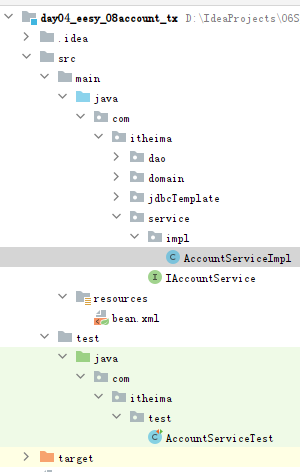
<?xml version="1.0" encoding="UTF-8"?><beans xmlns="http://www.springframework.org/schema/beans"xmlns:xsi="http://www.w3.org/2001/XMLSchema-instance"xsi:schemaLocation="http://www.springframework.org/schema/beanshttp://www.springframework.org/schema/beans/spring-beans.xsd"><!--配置业务层--><bean id="accountService" class="com.itheima.service.impl.AccountServiceImpl"><property name="accountDao" ref="accountDao"></property><property name="transactionTemplate" ref="transactionTemplate"></property></bean><!--配置账户的持久层--><bean id="accountDao" class="com.itheima.dao.impl.AccountDaoImpl"><!-- <property name="jdbcTemplate" ref="jdbcTemplate"></property>--><property name="dataSource" ref="dataSource"></property></bean><bean id="dataSource" class="org.springframework.jdbc.datasource.DriverManagerDataSource"><property name="driverClassName" value="com.mysql.jdbc.Driver"></property><property name="url" value="jdbc:mysql://localhost:3306/eesy02"></property><property name="username" value="root"></property><property name="password" value="root"></property></bean><!--配置事务管理器--><bean id="transactionManager" class="org.springframework.jdbc.datasource.DataSourceTransactionManager"><property name="dataSource" ref="dataSource"></property><!--注入连接池数据源--></bean><!--配置事务模板对象--><bean id="transactionTemplate" class="org.springframework.transaction.support.TransactionTemplate"><property name="transactionManager" ref="transactionManager"></property></bean></beans>
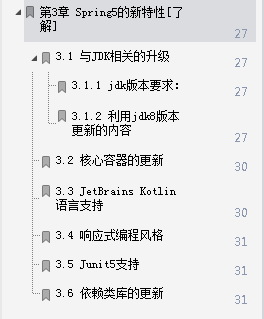
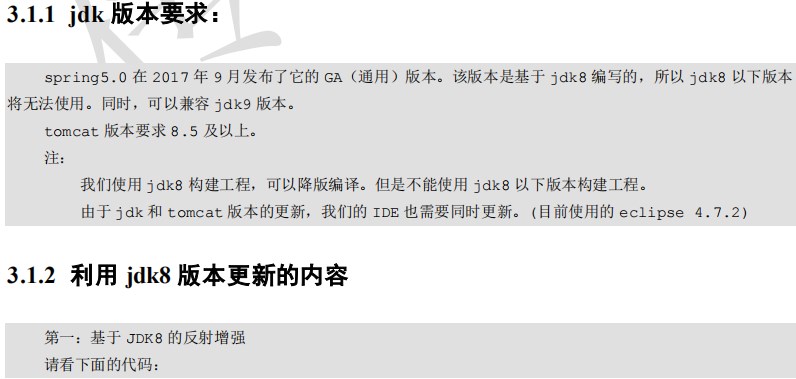

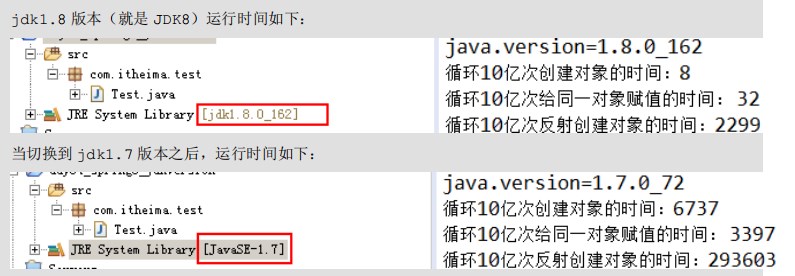
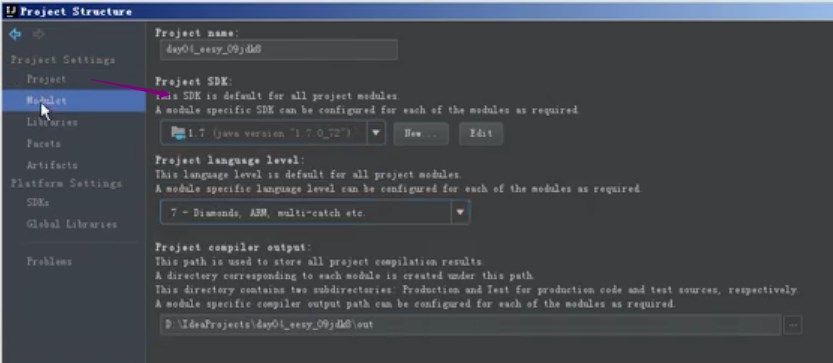
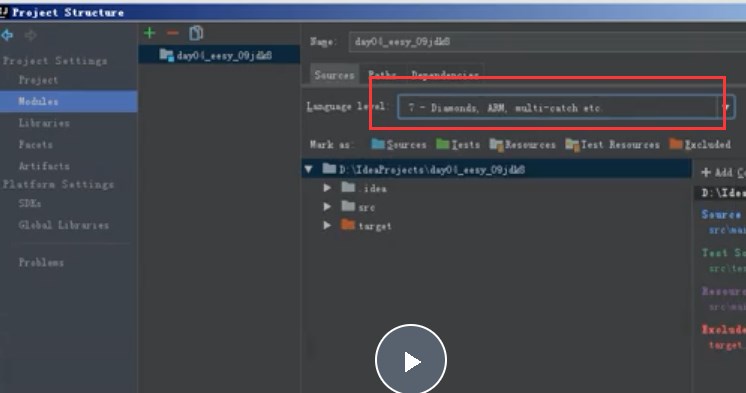
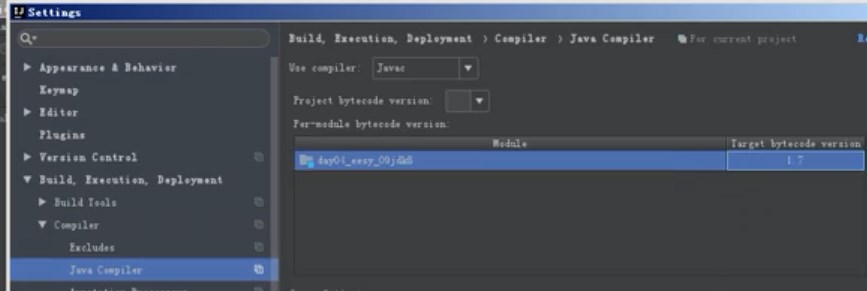
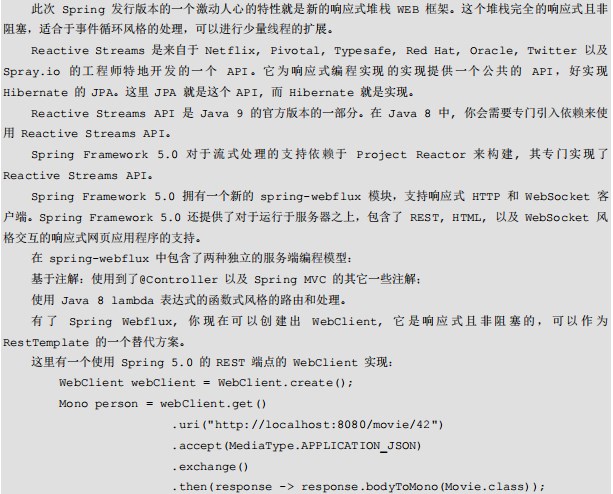
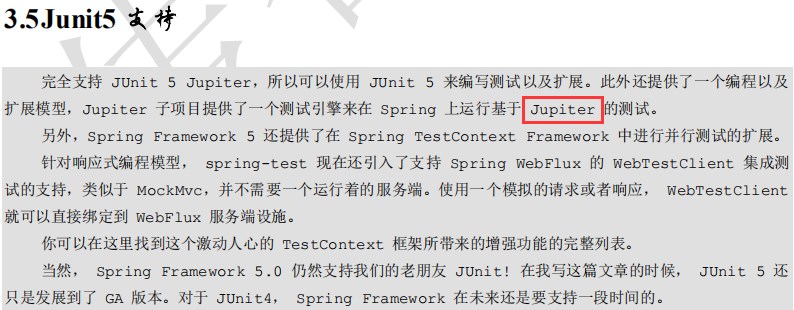
Spring04:JdbcTemplate及事务控制(AOP、XML、注解)的更多相关文章
- Spring jdbctemplate和事务管理器 全注解配置 不使用xml
/** * spring的配置类,相当于bean.xml */@Configuration//@Configuration标注在类上,相当于把该类作为spring的xml配置文件中的<beans ...
- 28Spring_的事务管理_银行转账业务加上事务控制_基于注解进行声明式事务管理
将applicationContext.xml 和 AccountServiceImpl 给备份一个取名为applicationContext2.xml 和 AccountServiceImpl2.j ...
- Spring的事务控制-基于xml方式
介绍:该程序模拟了转账操作,即Jone减少500元,tom增加500元 1.导入坐标 <dependency> <groupId>junit</groupId> & ...
- 使用Spring实现AOP(XML+注解)
一.Spring对AOP的支持 AOP并不是Spring框架特有的,Spring只是支持AOP编程的框架之一,每一个框架对AOP的支持各有特点,有些AOP能够对方法的参数进行拦截,有些AOP对方法进行 ...
- Spring第八篇【XML、注解实现事务控制】
前言 本博文主要讲解Spring的事务控制,如何使用Spring来对程序进行事务控制-. 一般地,我们事务控制都是在service层做的..为什么是在service层而不是在dao层呢??有没有这样的 ...
- Spring的事务控制-基于注解的方式
模拟转账操作,即Jone减少500,tom增加500 如果有疑问请访问spring事务控制-基于xml方式 1.创建数据表 2.创建Account实体类 public class Account { ...
- 阶段3 2.Spring_10.Spring中事务控制_1 基于XML的AOP实现事务控制
新建项目 首先把依赖复制进来 aop必须引入.aspectjweaver 复制src下的所有内容 复制到我们的新项目里面 factory文件夹删掉 删除后测试类必然就报错 配置文件 beanFacto ...
- Java实战之03Spring-05Spring中的事务控制(基于AOP)
五.Spring中的事务控制(基于AOP) 1.Spring中事务有关的接口 1.1.明确: JavaEE体系进行分层开发,事务处理位于业务层,Spring提供了分层设计业务层的事务处理解决方案 1. ...
- spring基于XML的声明式事务控制
<?xml version="1.0" encoding="utf-8" ?><beans xmlns="http://www.sp ...
- SpringBoot系列: JdbcTemplate 事务控制
============================Spring JdbcTemplate 事务控制============================之前使用 JDBC API 操作, 经常 ...
随机推荐
- Elasticsearch:Elasticsearch HQ 介绍
- Beats:通过Metricbeat实现外部对Elastic Stack的监控
- SonarQube 之 gitlab-plugin 配合 gitlab-ci 完成每次 commit 代码检测
转载自:https://cloud.tencent.com/developer/article/1010601 1.背景介绍 我们知道使用 SonarQube 可以在日常开发中检测代码质量,除了使用 ...
- C#-02 传入参数的一些用法2
C#_02 参数应用2 一.关于 "ref" 局部变量和 "ref" 返回 在前面已经明白了 ref 关键词传递一个对象引用给方法调用,这样在方法中对对象修改过 ...
- vue中的v-if查找数组中最后一个,给他加上新的样式
vue: var app=new Vue({ el:".xiaomi", data: { typeInfo: [{img:"image/type/phone_1.webp ...
- 自己动手写ls命令——Java版
自己动手写ls命令--Java版 介绍 在前面的文章Linux命令系列之ls--原来最简单的ls这么复杂当中,我们仔细的介绍了关于ls命令的使用和输出结果,在本篇文章当中我们用Java代码自己实现ls ...
- C语言之走迷宫深度和广度优先(利用堆栈和队列)
完成以下迷宫 利用二维数组储存每一个数组里的值,若是不能走则为1,若是可行就是0,走过了就设为2. 一般是再复制一个数组,用来记录. 堆栈的思想就是将一个点的上下左右都遍历一遍,若可行进栈,跳出遍历, ...
- 成功 解决 @keyup.enter=“search()“ 在el-input 组件中不生效的问题
1.问题描述 在输入框中.输入内容.点击回车.没有效果 问题代码 2.问题解决思路 查看官网的解释说明: 要使用.native修饰符 3.问题解决 修改后的代码 修改后的效果
- 【React】学习笔记(二)——组件的生命周期、React脚手架使用
原教程视频:ttps://www.bilibili.com/video/BV1wy4y1D7JT?p=2&spm_id_from=pageDriver 目录 一.组件的生命周期 1.1.生命周 ...
- 跟我学Python图像处理丨图像特效处理:毛玻璃、浮雕和油漆特效
摘要:本文讲解常见的图像特效处理,从而让读者实现各种各样的图像特殊效果,并通过Python和OpenCV实现. 本文分享自华为云社区<[Python图像处理] 二十四.图像特效处理之毛玻璃.浮雕 ...
